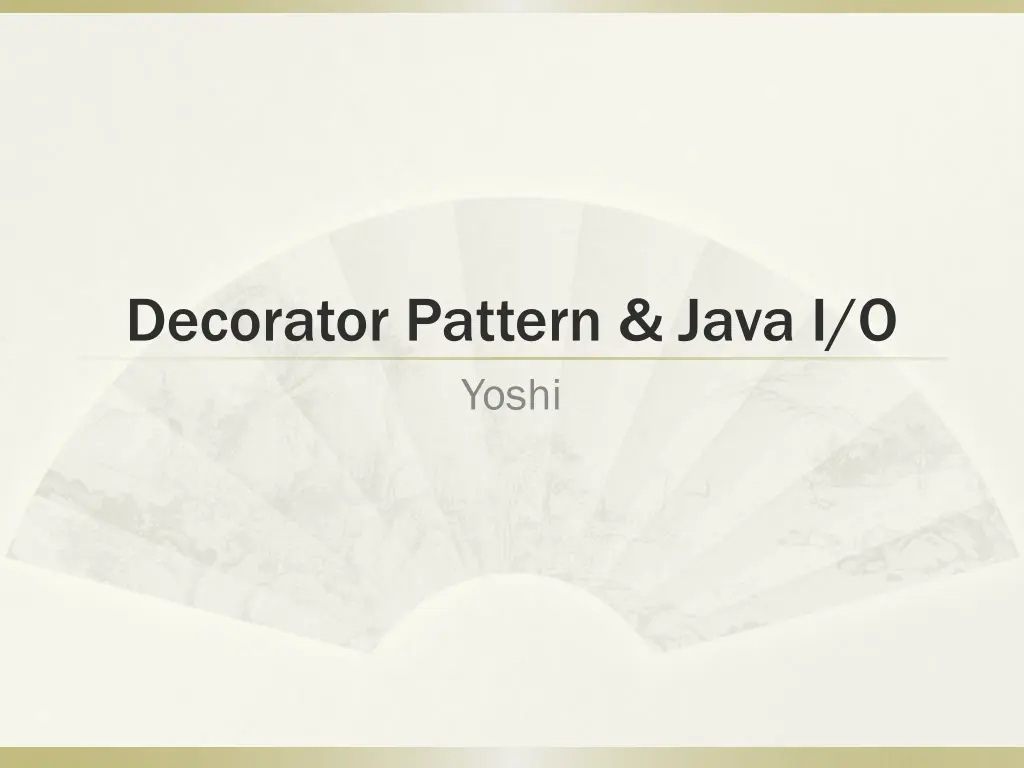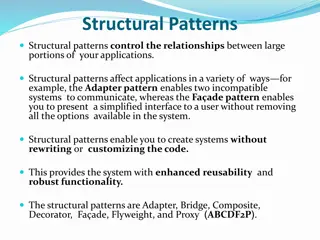
Understanding the Decorator Pattern in Java I/O with Yoshi
Learn about the decorator pattern in Java I/O through Yoshi's example. Discover how decorators can add new responsibilities to objects without changing the underlying classes, and explore the benefits and drawbacks of this design pattern.
Download Presentation

Please find below an Image/Link to download the presentation.
The content on the website is provided AS IS for your information and personal use only. It may not be sold, licensed, or shared on other websites without obtaining consent from the author. If you encounter any issues during the download, it is possible that the publisher has removed the file from their server.
You are allowed to download the files provided on this website for personal or commercial use, subject to the condition that they are used lawfully. All files are the property of their respective owners.
The content on the website is provided AS IS for your information and personal use only. It may not be sold, licensed, or shared on other websites without obtaining consent from the author.
E N D
Presentation Transcript
Why decorator? Once you know the techniques of decorating, you ll be able to give your (or someone else s) objects new responsibilities without making any code changes to the underlying classes. any code changes to the underlying classes. without making
SO SO
Abstract class description Abstract method getDescription() getPrice() getPrice() getPrice()
Abstract class description Abstract method getDescription() getPrice() Class getPrice() getPrice() getPrice() getPrice() ? ? getPrice() getPrice() getPrice()
? description int getPrice() { int price=0; if(has ()) { price+=5; } if(has ()) { getDescription() getPrice() has () set () has () set () has () set () has () set () has () set () has () has () price+=5; } if(has ()) { price+=7; } if(has ()) { price+=10; } return price; }
? (2) cost() int = super.cost(); int = + ; return ; cost()
Whats the drawback? ? ( )? ( )? ? SO ,
Decorator ? !
What we have now? Decorators have the same supertype object they decorate You can use more than one decorators as a chain to decorator a single object Decorators are transparent transparent, so we can replace original Component with a decorator one anywhere anywhere The decorator adds its own behavior either before and/or after delegating to the object it decorates to do the job Objects can be decorated at runtime! supertype as the
Participants Component Define an interface for objects that can have responsibility added to them dynamically Concrete component Define an object to which additional responsibility can be attached Decorator Maintain a reference to a Component object and define an interface that conform to Component s interface Concrete decorator Add responsibilities to the component
Question Why not just let ConcreteDecorator extend Component? Try the code!
Because This example is still too simple Let s take a look at the design of java.io
Can you map it back to decorator pattern?
See java.io.InputStream http://java.sun.com/j2se/1.5.0/docs/api/java/i o/InputStream.html java.io.FilterInputStream http://java.sun.com/j2se/1.5.0/docs/api/java/i o/FilterInputStream.html
java.io.InputStream Why only one abstract? Remember Template Method Pattern?
java.io.FilterInputStream The class FilterInputStream itself simply overrides all methods of InputStream with versions that pass all requests to the contained input stream. In short, delegation! Subclasses of FilterInputStream may further override some of these methods and may also provide additional methods and fields. In short, help you override all the methods defined in java.io.InputStream You can provide additional functionalities in decorators
RTFSC 26 package java.io; 45 public class FilterInputStream extends InputStream { 50 protected volatile InputStream in; 61 protected FilterInputStream(InputStream in) { 62 this.in = in; 63 } 82 public int read() throws IOException { 83 return in.read(); 84 } 106 public int read(byte b[]) throws IOException { 107 return read(b, 0, b.length); 108 } 132 public int read(byte b[], int off, int len) throws IOException { 133 return in.read(b, off, len); 134 } 141 public long skip(long n) throws IOException { 142 return in.skip(n); 143 }
158 public int available() throws IOException { 159 return in.available(); 160 } 171 public void close() throws IOException { 172 in.close(); 173 } 174 191 public synchronized void mark(int readlimit) { 192 in.mark(readlimit); 193 } 194 216 public synchronized void reset() throws IOException { 217 in.reset(); 218 } 219 233 public boolean markSupported() { 234 return in.markSupported(); 235 } 236 }
After RTFSC Without this, the all delegating works need to be done by yourself!
Finally Can you give an example to use this pattern?


















